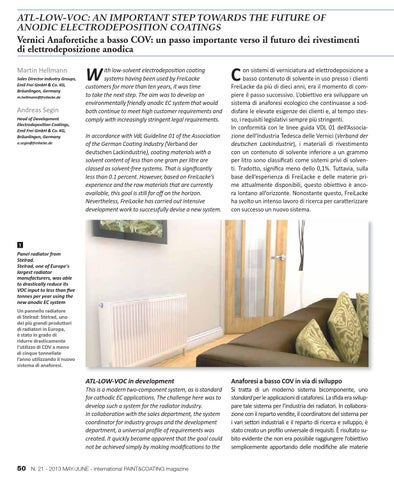ATL-LOW-VOC: AN IMPORTANT STEP TOWARDS THE FUTURE OF ANODIC ELECTRODEPOSITION COATINGS Vernici Anaforetiche a basso COV: un passo importante verso il futuro dei rivestimenti di elettrodeposizione anodica Martin Hellmann Sales Director Industry Groups, Emil Frei GmbH & Co. KG, Bräunlingen, Germany m.hellmann@freilacke.de
Andreas Segin Head of Development Electrodeposition Coatings, Emil Frei GmbH & Co. KG, Bräunlingen, Germany a.segin@freilacke.de
W
ith low-solvent electrodeposition coating systems having been used by FreiLacke customers for more than ten years, it was time to take the next step. The aim was to develop an environmentally friendly anodic EC system that would both continue to meet high customer requirements and comply with increasingly stringent legal requirements.
C
In accordance with VdL Guideline 01 of the Association of the German Coating Industry (Verband der deutschen Lackindustrie), coating materials with a solvent content of less than one gram per litre are classed as solvent-free systems. That is significantly less than 0.1 percent. However, based on FreiLacke’s experience and the raw materials that are currently available, this goal is still far off on the horizon. Nevertheless, FreiLacke has carried out intensive development work to successfully devise a new system.
on sistemi di verniciatura ad elettrodeposizione a basso contenuto di solvente in uso presso i clienti FreiLacke da più di dieci anni, era il momento di compiere il passo successivo. L’obiettivo era sviluppare un sistema di anaforesi ecologico che continuasse a soddisfare le elevate esigenze dei clienti e, al tempo stesso, i requisiti legislativi sempre più stringenti. In conformità con le linee guida VDL 01 dell’Associazione dell’Industria Tedesca delle Vernici (Verband der deutschen Lackindustrie), i materiali di rivestimento con un contenuto di solvente inferiore a un grammo per litro sono classificati come sistemi privi di solventi. Tradotto, significa meno dello 0,1%. Tuttavia, sulla base dell’esperienza di FreiLacke e delle materie prime attualmente disponibili, questo obiettivo è ancora lontano all’orizzonte. Nonostante questo, FreiLacke ha svolto un intenso lavoro di ricerca per caratterizzare con successo un nuovo sistema.
ATL-LOW-VOC in development
Anaforesi a basso COV in via di sviluppo
This is a modern two-component system, as is standard for cathodic EC applications. The challenge here was to develop such a system for the radiator industry. In collaboration with the sales department, the system coordinator for industry groups and the development department, a universal profile of requirements was created. It quickly became apparent that the goal could not be achieved simply by making modifications to the
Si tratta di un moderno sistema bicomponente, uno standard per le applicazioni di cataforesi. La sfida era sviluppare tale sistema per l’industria dei radiatori. In collaborazione con il reparto vendite, il coordinatore del sistema per i vari settori industriali e il reparto di ricerca e sviluppo, è stato creato un profilo universale di requisiti. È risultato subito evidente che non era possibile raggiungere l’obiettivo semplicemente apportando delle modifiche alle materie
1
Panel radiator from Stelrad. Stelrad, one of Europe's largest radiator manufacturers, was able to drastically reduce its VOC input to less than five tonnes per year using the new anodic EC system Un pannello radiatore di Stelrad: Stelrad, uno dei più grandi produttori di radiatori in Europa, è stato in grado di ridurre drasticamente l’utilizzo di COV a meno di cinque tonnellate l’anno utilizzando il nuovo sistema di anaforesi.
50 N. 21 - 2013 MAY/JUNE - international PAINT&COATING magazine
